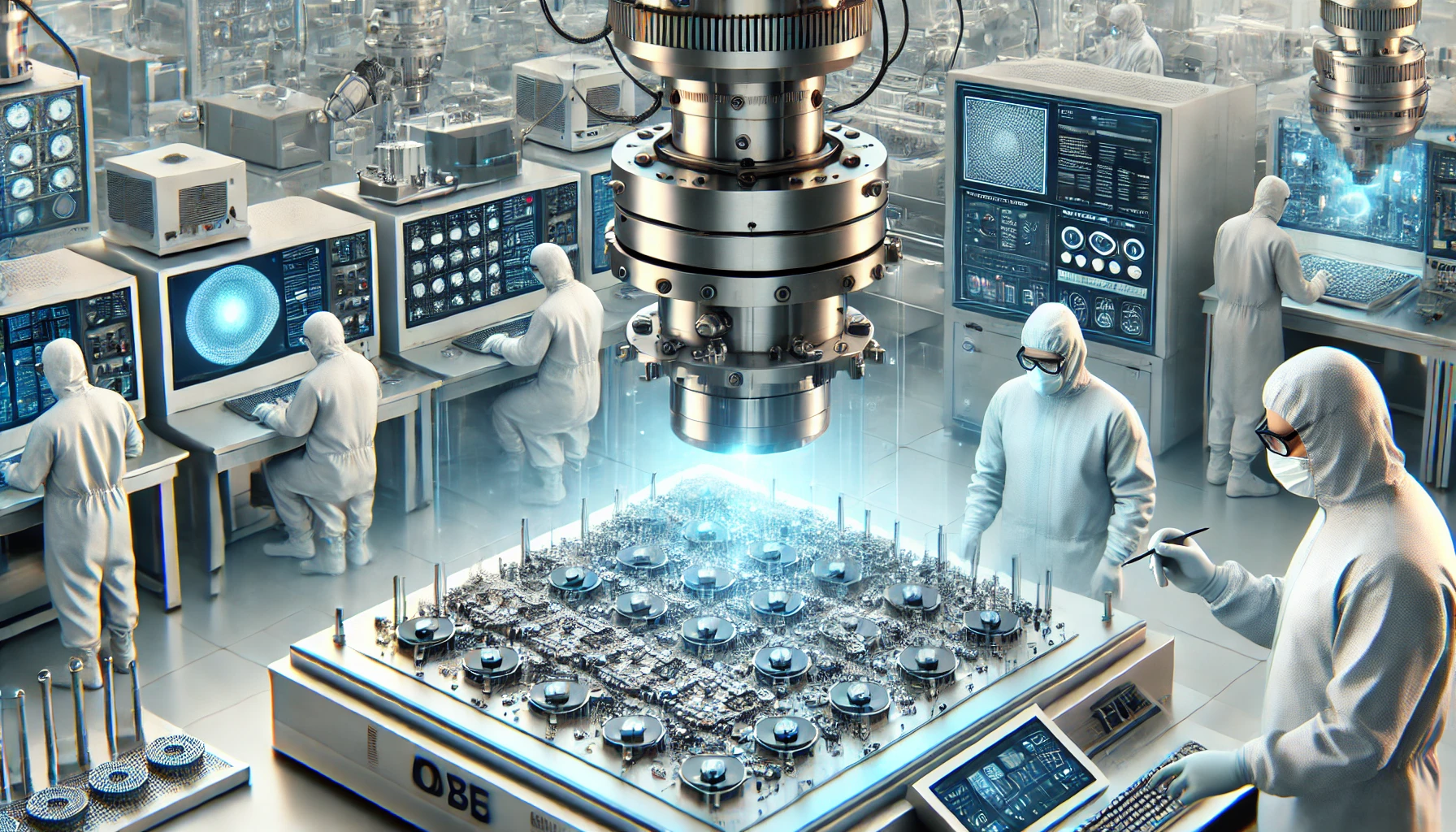Manufacturing Qubits for Quantum Computer in Quantum Industry

Key Takeaways
- Manufacturing qubits is crucial for advancing quantum computer technology.
- Quantum computing promises enhancements in areas like drug discovery, data analysis, and forecasting models.
- Silicon-based technologies are attractive due to existing CMOS fabrication infrastructure.
- The quest for silicon quantum computing began with Bruce Kane's proposal in 1998.
- Addressing qubit error correction and scaling remains a significant challenge in the semiconductor equipment industry.

The endeavor to produce quantum computers, which deploy quantum mechanics for computational supremacy, has honed in on qubit generation as a critical facet. Advancing from theory to practice, quantum computing portends progress in sectors such as drug discovery, data analysis, and forecasting. Google's recent 'quantum supremacy' announcement has significantly energized the field, fostering partnerships between industry leaders and academia to hasten advancements.
Unlike classical binary bits, qubits facilitate superpositions of states and quantum entanglement. These attributes are key to the potentaQuantum computers, promising unprecedented computational power, have been an object of fascination for scientists and tech enthusiasts alike. These advanced machines hold the potential to revolutionize industries across the board, from pharmaceutical research to financial modeling. But to unleash the full capabilities of quantum computing, scientists face a significant challenge: manufacturing qubits, the fundamental building blocks of quantum computers. These tiny units of information, equivalent to the classical bits found in traditional computers, are responsible for storing and processing data using the mind-bending properties of quantum mechanics. In this article, we will explore the current state of qubit manufacturing, focusing on silicon-based approaches that leverage well-established CMOS fabrication methods. Join us as we delve into the fascinating world of quantum computer manufacturing and the technologies shaping its future.
l enhancement in quantum computers' processing speeds. Currently, the emphasis is on silicon-based approaches, striving to apply well-established CMOS fabrication methods.
Bruce Kane's 1998 concept at the University of New South Wales laid the groundwork for silicon quantum computing. His suggestion involved using phosphorus atoms in silicon to manage qubits via nuclear spins. The synergy of quantum phenomena with the trend of shrinking silicon devices, following Moore's law, redirects the industry towards a "more-than-Moore" evolution. This path underscores silicon's benefits as a substrate for creating a quantum-friendly, low-noise processing environment.
The durability of silicon against noise, along with its match with existing semiconductor equipment, carves a promising route for aligning quantum processors with standard electronics. Tackling qubit error correction, adding redundancy, and achieving a scale of millions of qubits, however, poses a formidable challenge. This predicament underscores the vital role of careful strategy in the development of quantum device fabrication.
Introduction of qubits for Quantum Computer
Quantum computing's underlying component, the qubit, transcends the limitations of classical bits. It does so by harnessing quantum states to embody superpositions and entanglement. This enables a level of computational prowess that may eclipse classical supercomputers presently.
Significant headway in creating quantum dots, predominantly those based in silicon, has emerged with remarkable uniformity and efficiency. This feat has been achieved through the application of electron beam evaporation and magnetron sputtering techniques within the realm of semiconductor fabrication. Such precision in construction has led to superior qubit functionality.
Designs have evolved to include multi-electron quantum dots, known for their ability to control tunnel barriers meticulously. This control is essential for correcting qubit errors. Simultaneously, qubit operations at a single-spin level exhibit noteworthy relaxation and coherence durations. The current qubit fidelity rate, exceeding 99%, underscores astounding advancements, establishing the foundation for highly scalable gate-defined quantum dot arrays with adjustable couplings.
The progress in industrial semiconductor technology further propels these innovations. It relies on intricate manufacturing approaches that integrate ebeam and e gun methodologies in the fabrication of quantum dot arrays. These methods are finely tuned to the demanding specifications of quantum computation.
Yet, achieving harmony between the refinement of industrial standards and the fragile coherence of quantum states poses a significant challenge. The manufacturing of qubits necessitates a delicate equilibrium to meet both robust requirements and the ultimate goal of fault-tolerant quantum computing reality.
"The introduction of qubits for quantum computers marks a significant milestone, leveraging established semiconductor techniques to pave the way for the next generation of computing." - Industry Expert
Challenges of qubits for Quantum Computer
Developing qubits for quantum computer applications is fraught with complexity. This is driven by the formidable ambition to achieve millions of qubits, each boasting high fidelity and controllable interactions. The evolution of industrial semiconductor processes has led to the creation of quantum dots with remarkable uniformity and yield. Nonetheless, adapting these techniques for qubit fabrication introduces significant hurdles. The challenge is to meet strict coherence requirements, which are highly sensitive to the influences of microscopic variations and defects within the interface and surrounding materials.
The fabrication complexity of qubits is significantly compounded by their vulnerability to industrial processes like chemical mechanical polishing. Through the avoidance of such techniques in smaller-scale processes, like electron-beam lithography, to the requirement of these processes in large-scale quantum device fabrication, a stark transition exists. The challenge is to adapt fully optical patterning, synonymous with current commercial integrated circuit production, to the specific layout needs of qubit devices while ensuring metallurgical consistency across the wafer. This adaption is indispensable for ensuring qubits remain operational through the manufacturing journey.
To combat these hurdles, semiconductor process integration must be meticulously navigated to safeguard quantum mechanical integrity. The expedition from the rudimentary exploration of quantum computing to its industrial-scale realization necessitates a delicate balance. It's a balance between the exacting needs of qubit performance and the intricacies of large-scale semiconductor manufacturing. It is essential to guarantee the qubits not only endure but also function flawlessly in industrial settings. This step is pivotal for the successful transition of quantum computing from theory to commercial reality.
FAQ
What are the key components necessary for manufacturing a quantum computer?
Manufacturing a quantum computer requires essential components like qubits, semiconductor tools, and sophisticated fabrication techniques including magnetron sputtering and electron beam evaporation. The paramount task is to maintain the coherence
Key components necessary for manufacturing a quantum computer are crucial in paving the way for the revolutionary computing power promised by this advanced technology. One such essential component is the qubit, the fundamental unit of information in a quantum computer. Qubits harness the unique properties of quantum mechanics, such as superposition and entanglement, to perform computations exponentially faster than traditional computers.
In addition to qubits, an effective quantum computer requires a solid and reliable infrastructure. This includes a highly controlled and stable environment, often achieved through the use of cryogenic systems that maintain extremely low temperatures to prevent the qubits from decohering. These systems enable the manipulation and measurement of qubits, ensuring their coherence and fidelity during computations. Maintaining the integrity of qubits is essential for achieving the computational edge that quantum computers promise.
Another crucial component is a sophisticated control system that allows for precise manipulation of qubits. This control system must be able to apply and read quantum gates, which are essential for performing calculations in a quantum computer. Additionally, quantum computers often rely on superconducting circuits, which are manufactured using techniques like magnetron sputtering and electron beam evaporation. These fabrication methods allow for the precise deposition of thin films and the creation of superconducting structures necessary for the functioning of qubits.
Ultimately, manufacturing a quantum computer requires expertise in various fields, including physics, material science, and engineering. By developing and integrating these key components, scientists and engineers can unlock the tremendous potential of quantum computing, revolutionizing industries such as cryptography, optimization, and drug discovery. As research and development continue to advance, the manufacturing process for quantum computers will undoubtedly become more refined, bringing us closer to harnessing the power of this transformative technology.
and fidelity of qubits, essential for the quantum computer's computational edge.
What makes qubits different from classical binary bits?
Unlike classical bits, qubits are capable of superposition and entanglement, enabling them to be both 0 and 1 at once. This unique ability endows quantum computers with potential supercomputing powers, distinguishing them from their classical counterparts.
Why is silicon considered a viable material for quantum computing?
Silicon is preferred for quantum computing due to its noise resilience and compatibility with CMOS practices. Its integration with existing semiconductor structures offers a practical route for melding quantum processors with current electronics, facilitating quantum technological advancements.
How did Bruce Kane contribute to silicon quantum computing?
In 1998, Professor Bruce Kane proposed a method at the University of New South Wales that involved utilizing phosphorus-doped silicon to handle and control qubits utilizing nuclear spins. His pioneering contribution established the groundwork for exploration and advancement in silicon-based quantum computing technologies.
What are the primary challenges in qubit fabrication?
Fabricating qubits poses unique hurdles, including the achievement of superior fidelity and coherence, error correction, and the prospect of scaling to millions. Overcoming these challenges necessitates careful planning and a tailored application of industrial semiconductor techniques to the microscale structures of quantum dots and qubits.
How do industrial processes impact qubit manufacturing?
The transformation of industrial semiconductor methods, known for their effectiveness in mass production, is crucial to maintain qu
When it comes to manufacturing quantum computers, a significant consideration is the impact of industrial processes on qubit fabrication. Qubits, the building blocks of quantum computers, are fragile and easily influenced by their surroundings. Consequently, various industrial processes must be carefully adjusted to protect the delicate quantum nature of these qubits during manufacturing.
One essential aspect is maintaining qubit coherence, which refers to the ability of qubits to retain their quantum state without being disrupted by external factors. To achieve this, strategies such as chemical mechanical polishing and ebeam or e gun lithography need to be tailored to minimize any interference. These processes involve removing unwanted materials or creating nanostructures, respectively, and their optimization is crucial in preventing disruptions to qubit coherence.
Moreover, the choice of materials used in the manufacturing process plays a significant role. Materials that exhibit less susceptibility to external interference, such as superconductors or semiconductors with fewer impurities, are often favored for qubit fabrication. The selection of suitable materials ensures higher qubit coherence and improves the overall performance of the quantum computer.
In summary, industrial processes have a notable impact on the manufacturing of qubits for quantum computers. To preserve qubit coherence, strategies like chemical mechanical polishing and ebeam or e gun lithography must be adjusted. Additionally, the choice of materials used in fabrication plays a crucial role in minimizing external interference. By carefully considering these factors, researchers and manufacturers can continue to advance the development of quantum computers and unlock the immense potential they hold for solving complex problems.
bit coherence. Strategies like chemical mechanical polishing and ebeam lithography must be adjusted to protect the delicate quantum nature of qubits during the manufacturing process.
What methodologies are being used to fabricate qubits?
Currently, methodologies such as electron beam evaporati
and molecular beam epitaxy (MBE) are being used to fabricate qubits for quantum computers. These methodologies involve depositing and manipulating layers of material at the atomic level to create the structures necessary for qubit operation.
Electron beam evaporation is a technique that involves heating a material in a vacuum chamber until it evaporates and then condenses onto a substrate, forming a thin film. This process allows for precise control over the deposition of the material, enabling the creation of complex qubit architectures. Additionally, the use of electron beams allows for the fine-tuning of the deposition rate and energy, further enhancing the control over qubit fabrication.
On the other hand, molecular beam epitaxy utilizes beams of atoms or molecules that are directed onto a substrate, where they form crystalline layers. This technique offers the advantage of creating high-quality single-crystal thin films, which are crucial for maintaining the coherence and stability of qubits. By carefully controlling the deposition conditions and the beam flux, researchers can achieve the desired film thickness and composition necessary for qubit fabrication.
Both electron beam evaporation and molecular beam epitaxy play vital roles in the advancement of quantum computing. These methodologies are instrumental in achieving the precise control and accuracy required for fabricating qubits with the desired properties, such as long coherence times and low error rates. As quantum computing continues to evolve, further research and development in fabrication methodologies will be necessary to push the boundaries of qubit performance and pave the way for future breakthroughs in this revolutionary technology.
on, electron guns, and magnetron sputtering are instrumental in creating qubits. These techniques offer control over tunnel barriers and contribute to increased fidelity and coherence times within semiconductor contexts, vital for qubit manufacturing.
What role does optical lithography play in quantum dot fabrication?
Optical lithography plays a critical role in quantum dot manufacturing, ensuring high uniformity and productivity. It permits the precise creation of layouts and processes necessary for qubit devices while uniformly distributing the metallurgical properties of the substrate. Such applications sustain the integrity of qubits, an indispensable element for quantum computation.
Source Links
- https://physicsworld.com/a/manufacturing-silicon-qubits-at-scale/
- https://www.space.com/purest-silicon-could-lead-to-first-million-qubit-quantum-computing-chips
- https://www.nature.com/articles/s41928-022-00727-9


